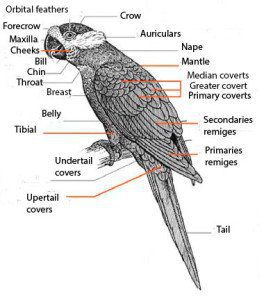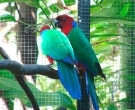Content
|
|---|
Description
45 cm. of length and weight approximate of 280 g..
The Red Shining-Parrot (Prosopeia tabuensis) It is the most distinctive of the colorful parrots of Fiji. It is a large parrot.
Their coloration are distinguished from the other two species. Its head, neck and underparts a brilliant scarlet hues with a blue collar extending behind the neck; the back and tail are a bright green. The flight feather and tail they are green, strongly impregnated with blue.
The bill and legs are black, and irises are orange.
The males and females they are similar, However, the bill the male is larger and the head It has a more square than the females form.
- Sound of the Red Shining-Parrot.
Description 2 subspecies:
-
(Gmelin) 1788 – The species nominal
Prosopeia tabuensis tabuensis
-
(Layard,THE) 1876 – 40 cm.. length approximately; more small that it nominal species, without the band blue on the nape, the feathers of the abdomen with a tone more blue and with the face less blackish.
Prosopeia tabuensis taviunensis
Habitat:
The Red Shining-Parrot are distributed in the mature forests and through a variety of associated habitats, including the of secondary growth, wooded ravines (nest), coconut plantations, Gardens of villages, agricultural fields, mangroves and scrub.
There has been starting from the 100 meters of altitude until the 1.750, but they are most common between the 400 and 1.000 m.
The Red Shining-Parrot they are suspicious, curious and You can see them individually, in pairs or in flocks of up to 40 individuals outside the breeding season. they are not shy, and loud groups tend to meet in their favotitos places to eat.
They tend to rest on the tops of the trees.
Reproduction:
The Red Shining-Parrot perch upright and turn head rhythmically back and forth, probably showing a form of courtship.
The breeding is in the months from July to October, in trees dead or broken, the female feeds the young.
Of 2-3 eggs that is hatch during 23-24 days.
The juveniles they can fly to the 8 weeks.
Food:
Feeding of the fruits and seeds a variety of trees, for example, Myristica hypargyraea, that is of particular importance in 'USA. They also feed on Mango Mangifera indica, papaya Carica papaya, guava Psidium guajava and bananas. Son agile climbers and move in search of food using their beaks to rely on small branches. Sujentan foods with their claws, since they bite with its powerful beak, and they chew the wood to remove insect larvae.
They feed mainly in the upper canopy, but sometimes also attack the cornfields.
Distribution:
Size of the area of distribution (reproduction / resident): 6.200 km2
The Red Shining-Parrot they are distributed in a natural way in the islands of the Group Fiji including Vanua Levu, KIOA, Taveuni, Qamea, Laucala, Koro and Gau (probably introduced). In Tonga, the species was introduced in Tongatapu prior to contact with the European and where it has already extinct due to habitat loss, and in 'USA where it is still quite common, especially in the forests of the East, North and South-West (with a population estimated between 700- 1.000 birds in 1988).
The species benefits, in part, Thanks to agriculture, but they depend largely on its nest in mature trees of the forest, trees that are being cleared in most of its extension. The species is also threatened by trade, and it is also hunted for its feathers and as food.
Many juveniles are caught to be raised locally as pets, Since they learn to talk easily.
Its population is believed that it may be above the 20.000 specimens, but of the subspecies prosopeia remaining, probably, less than 5.000 birds and its status is of concern.
There has been a sharp decline in the population of the Red Shining-Parrot in some areas due to habitat loss, although the species remains locally common at lower elevations on most of its islands.
Distribution 2 subspecies:
-
(Gmelin) 1788 – The nominal species
Prosopeia tabuensis tabuensis
-
(Layard,THE) 1876 – Taveuni, Ngamea (Qamea) and Laucala, in the North of Fiji.
Prosopeia tabuensis taviunensis
Conservation:
• Current Red List of UICN: Least concern.
• Population trend: Decreasing.
The size of the world population It has not been quantified, but the species is described as common and visible throughout its area of distribution (Watling 2001).
The population It is suspected that it may be in decline due to ongoing habitat destruction.
"Red Shining-Parrot" in captivity:
Very rare in captivity.
According to sources, one specimen was still alive after 6,8 years in captivity. Taking into account the longevity of the similar species, the maximum longevity in these animals could be underestimated. Es un hecho que estos animales pueden vivir hasta 23.7 years in captivity, aunque en esta especie no ha sido verificado.
Alternative names:
– Red Shining-Parrot, Maroon Shining Parrot, Maroon Shining-parrot, Red Shining Parrot, Red-breasted Musk Parrot, Red-breasted Musk-Parrot, Red-breasted Shining-Parrot (ingles).
– Perruche pompadour, Perruche masquée pompadour (French).
– Pompadoursittich, Pompadour Sittich (German).
– Prosopeia tabuensis (Portuguese).
– Papagayo Carmín, Papagayo Granate (español).
scientific classification:

– Order: Psittaciformes
– Family: Psittaculidae
– Genus: Prosopeia
– Scientific name: Prosopeia tabuensis
– Citation: (Gmelin, JF, 1788)
– Protonimo: Psittacus tabuensis
Images “Red Shining-Parrot”:
Videos "Red Shining-Parrot"
“Red Shining-Parrot” (Prosopeia tabuensis)
-
Sources:
– Avibase
– Parrots of the World – Forshaw Joseph M
– Parrots A Guide to the Parrots of the World – Tony Juniper & Mike Parr
– Birdlife
– Photos:
(1) – Red Shining-parrot Prosopeia tabuensis in captivity, Fafa Island, Tonga By Duncan Wright (Own work) [GFDL or CC BY-SA 3.0], via Wikimedia Commons
(2) – A painting of a Maroon Shining Parrot by Edward Lear 1812-1888 Edward Lear [Public domain], via Wikimedia Commons
(3) – Red Shining-parrot (Prosopeia tabuensis) De Voeux Peak, Taveuni, Fiji Islands By Aviceda (Own work) [CC BY-SA 3.0], via Wikimedia Commons
(4) – Maroon Shining Parrot Prosopeia tabuensis Kula Eco Park – Viti Levu, Fiji © 2007 Sarah P. Otto – The Online Zoo
(5) – A bird foraging on the ground by Josep del Hoyo – Lynx
(6) – A bird perched in a tree by Josep del Hoyo – Lynx
– Sounds: Matthias Feuersenger (Xeno-canto)






